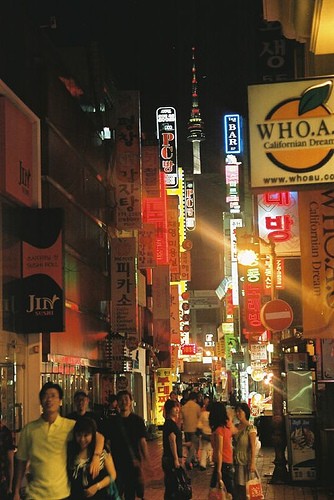
Welcome to the new year of Ethnic Eating 101! Sorry for the unannounced hiatus; I was hung over–tequila is a delicious but cruel potion.
While the wonders of Vietnamese cooking could fill up half a year's posts, the Vietnamese are not the only group with a large presence in Orange County. This week, we travel to Korea and explore the single most popular Korean food in the United States: barbecue.
Los Angeles has the largest expatriate Korean population in the
world; it was only natural that Koreans would plant roots in places
outside Koreatown, which is why there are Koreans in La Crescenta,
Rowland Heights and Torrance. Here in Orange County, there are large
concentrations of Korean restaurants in Buena Park, Garden Grove,
Irvine and, increasingly, Stanton.
]
Koreans patronize restaurants
a little bit differently than Americans; when you want to eat Korean
food, you decide what you want, and then you go to a restaurant that
specializes in it. This sounds like a blinding flash of the obvious,
but it isn't: often a Korean restaurant will not have anything on its
menu but its speciality, whereas a Vietnamese or Chinese restaurant
will usually be willing to make something if they have the ingredients.
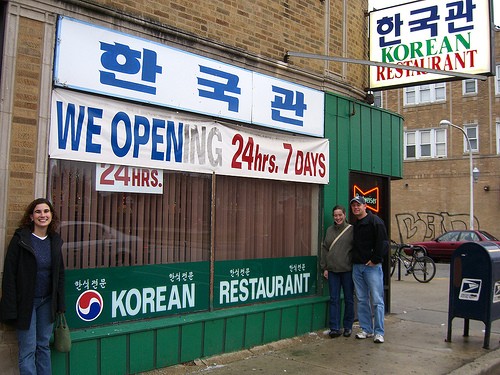
Korean restaurants are also, as of this writing, some of the least-assimilated dining experiences available in the area. That's a bold sentence but if you look at other ethnicities' restaurants as a whole, you'll find that they generally have made some concessions here and there to American tastes and American service. This is less so with Korean restaurants, where the chiles flow with abandon (Korean food is often extremely spicy, be warned!).
It starts with the fact that Korean restaurants will often only be labelled in Korean, with a small English sign that has the transliterated name of the place (Woo Lae Oak, Cham Sut Gol, etc.) and “Korean restaurant”. While Korean writing (called hangul) is actually a breathtakingly elegant model of simplicity, for all that it looks like angular Chinese, most people aren't language geeks like I am and are not going to bother learning it just to eat in a restaurant.
How, then do you tell what is what? Unfortunately, the answer is to ask questions of people who would know, and to do research online before venturing out. If you're quite adventurous, you can walk into a busy restaurant, see what everyone is eating, and point; I have done this on a couple of occasions and been both happily and sadly surprised.
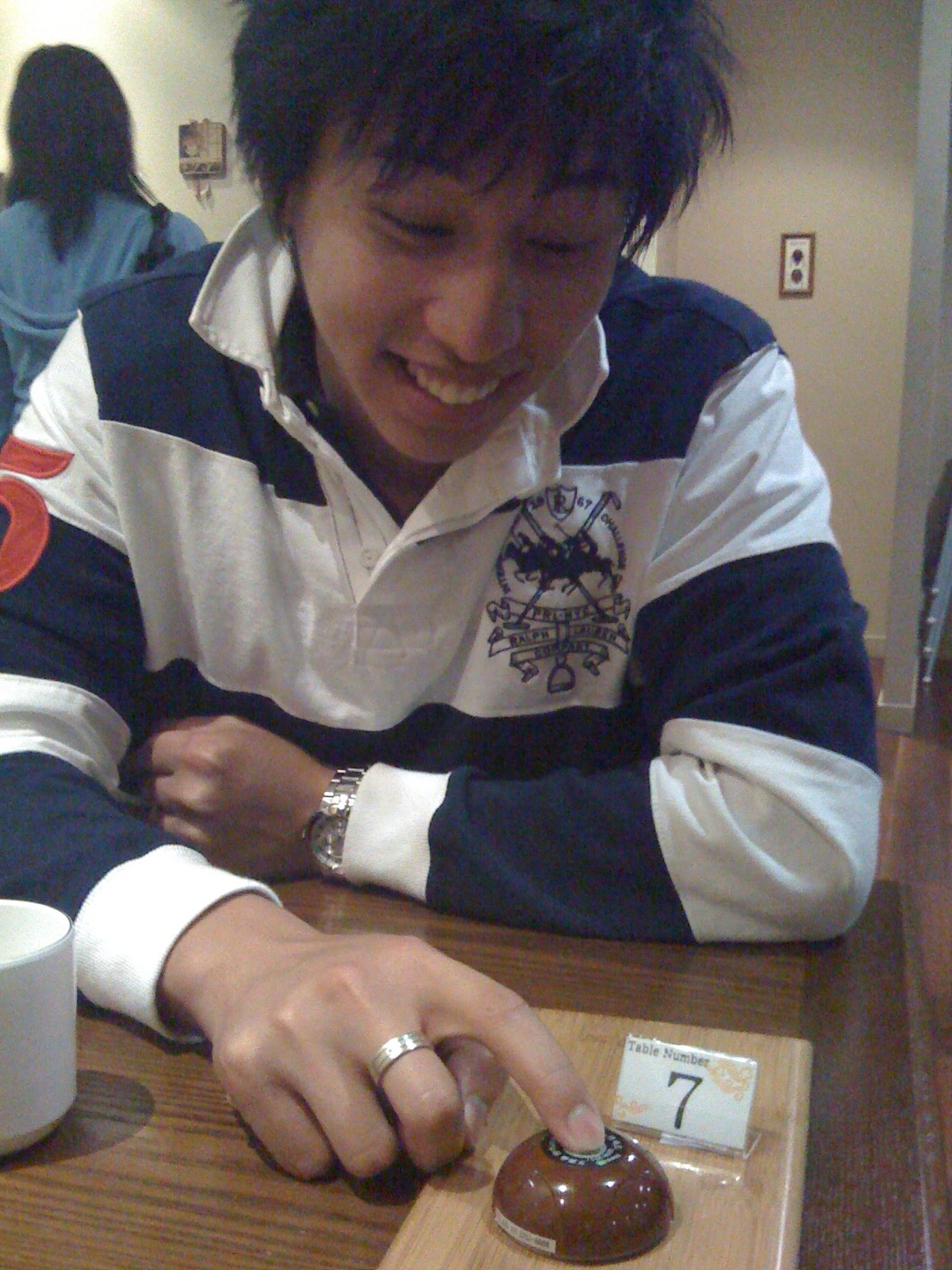
A word about Korean-style service: unlike Vietnamese, where you are expected to pay the bill at the place bills are paid (i.e., the cash register), Korean restaurants are nearly all full table service. You will need to signal when you need something. You will often see large groups of Koreans eating together and the idea is for the servers to appear only when required and let the guests enjoy themselves. If you want to try out a little Korean, the polite way to signal someone's attention is by saying, “yogiyo” (with a hard G like “girl”). This means “here” and is sort of the verbal equivalent of a polite cough.
This need to signal politely has given rise to the single best contribution to restaurant service in any cuisine whatsoever: the service button, what I lovingly call the “get over here” button. These are little electronic buttons located somewhere on every table (along the edge, near the condiments, up on the wall, etc.). When you need something, you press the button and a server comes to your table. I cannot for the life of me figure out why these are not more widespread; they're a great idea. Some of the nicer Korean restaurants have the buttons but pride themselves on customers never having to use them. The level of service, particularly in barbecue restaurants, is often very good, with waitstaff anticipating your needs.
Enough about the service for now; let's get to the food.[The single most popular Korean dish in America is Korean barbecue. Koreans are great eaters of meat, and a trip to a barbecue restaurant is both comforting and exotic at once. Korean barbecue involves sitting down at a table with a grill in the middle. Plates of raw meat, marinated and not, are brought to the table and you grill them to your liking in the middle.
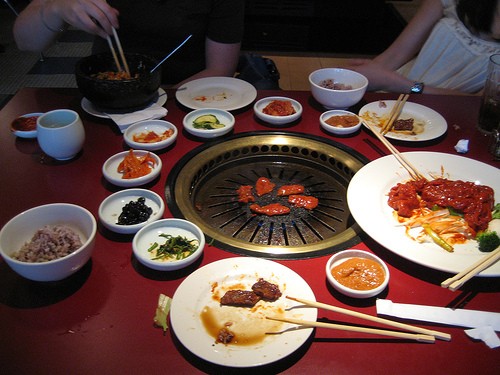
What you order is entirely up to you, but bear in mind that many places will not fire up the grill unless you order at least two plates of meat. More upscale places will lube the grill for you with a piece of beef tallow; some places rub garlic, mushrooms or cut onions on the grill.
A great place to start if you're new to Korean barbecue is bulgogi, thinly-sliced beef steak that has been marinated in a mixture of soy, garlic, ginger, scallions, Korean rice wine and sesame oil. Don't cook this too long or it will turn into Korean beef jerky.
A similar dish is thinly-sliced pork in a similar marinade with a heaping helping of chiles, called daeji bulgogi. While it smells unbelievably spicy on the plate, the char from the grill actually sweetens the dish slightly as well as lending a smoky flavor to it. If you've got to have chicken, chunks of chicken, called dak bulgogi, are usually available, but this tends to be one of the less popular dishes as it dries out easily on the grill.
Samgyeopsal is unmarinated pork belly; some barbecue restaurants specialize in this and you'll be able to tell because the server will look at you incredulously if you don't order it. Cook this to the side to soften the fat, then char briefly over the high heat in the middle to lend the smoky tang to it–and eat the fat too, it's the best part of the dish.
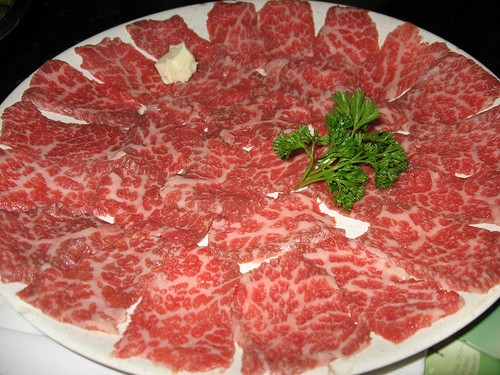
The most popular dish for both Koreans and non-Koreans is called kalbi; it is beef short ribs, marinated or not, served on the bone. Grill it carefully, as you would an expensive steak. Kalbi tastes best cooked over charcoal but it's usually very good no matter what the cooking fuel is. If you're given the choice to have bone-in or bone-out, go for bone-in; it will have better flavor and the best meat will be closest to the bone.
One thing that isn't ordered as it should be is chadolbaegi, unmarinated brisket. In more upscale restaurants, the server will wheel over a portable hot plate with an iron pan and cook the brisket for you (it is paper-thin). Some places will offer octopus, live prawns, squid or oysters (these are cooked in the shell so that the smoke penetrates the brine).
One word of caution: there are a few places that serve all-you-can-eat
meat. Be aware that while these places can look like a good value, they
still have to turn a profit on it, and it's the quality of the meat
that suffers. If you have a large group, it can be fun, but you aren't
going to have any mind-bending meat and the restaurant will typically
not serve the more expensive cuts of meat. Quality of meat
notwithstanding, all-you-can-eat KBBQ is better than no KBBQ, but don't
expect too many panchan or many of the little niceties.
Where to get it? Korean barbecue is everywhere. Some good choices are Surah (5333 Beach Blvd., Buena Park), Sagan (7801 Beach Blvd., Buena Park), Morangak (9651 Garden Grove Blvd., Garden Grove), Shik Do Rak (14775 Jeffrey Rd., Irvine; 9691 Garden Grove Blvd., Garden Grove) and Cham Sut Gol (9252 Garden Grove Blvd., Garden Grove).[
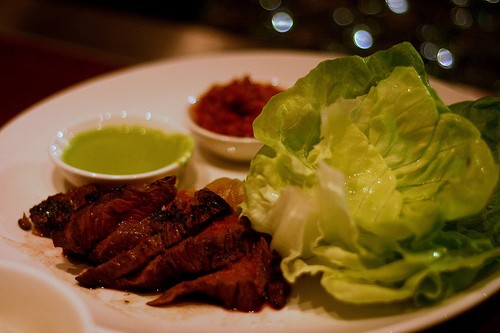
Korean barbecue is often served with items to wrap the meat in, called ssam. The most common offering is romaine or green leaf lettuce (ask for this at any restaurant; there will usually be a small upcharge).
Very upscale places may provide a plate of perilla leaf (purple on one side, green on the other), called kkaennip. You may see this advertised as sesame leaf; the leaves have some similarity but nearly all leaves will be perilla. Another wrapping option is sweet, vinegary daikon radish, sliced so thinly as to be translucent, and yet another is thinly-sliced, shiny, white, sticky rice wraps called ddeok bo ssam (the first word sounds like “duck”), which means “rice cakes for wrapping”. Shik Do Rak advertises itself as “the home of dduk bo ssam”; this is the most popular place to get it.
When any ssam is served, you will normally be given small dishes of chile and bean paste, called ssamjang (“wrapping sauce”), thinly-sliced garlic, and thinly-sliced jalapeño peppers. Upscale places may also give you freshly-ground pepper or smoked salt mixed with toasted sesame seeds.
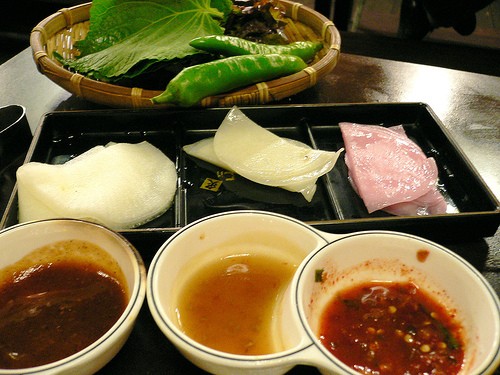
To eat a lettuce ssam, use your chopsticks to dip your meat in whatever condiments you would like (they are normally individual servings, so you don't have to worry about double-dipping), then place in the lettuce, wrap like a burrito and eat with your fingers.
To eat the other kinds of ssam, use your chopsticks to dip your meat in your condiments, then set your meat on the plate. Use the chopsticks to pick up the ssam (this may take some coaxing with your fingers in the case of ddeok, which is normal and expected), drop the ssam on the meat, and then pick the whole thing up with your chopsticks and eat it.[
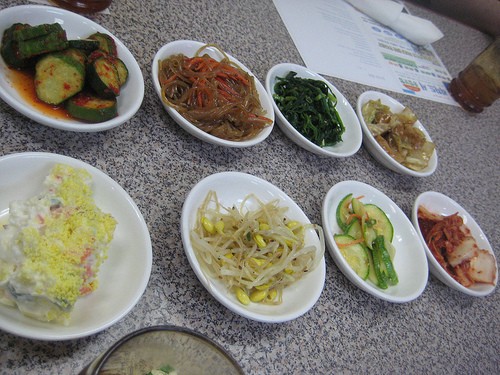
You'll notice that once you've placed your order, servers will come around with small bowls of food. At better restaurants, your table will nearly be covered with little side dishes, called panchan (or banchan–transliterated Korean will often switch p/b, k/g, r/l, t/d and j/ch). No Korean meal ever goes without panchan.
These are appetizers, palate cleansers and side dishes all in one. There are hundreds of kinds of panchan, though the core types number perhaps a dozen.
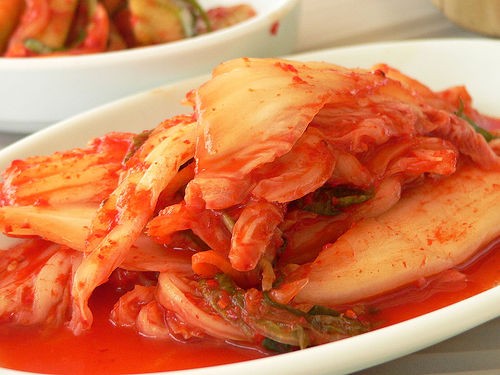
Kimchi, the first dish Americans think of when they think of Korean food, is usually served as leaves of napa cabbage mixed with red chile pepper, vinegar, salt and sometimes anchovies (vegetarians beware!) and left to ferment. The longer the kimchi ferments, the more tannic and sour it gets. Some people love “old” kimchi, some prefer new kimchi.
Kimchi can also refer to marinated cubes of radish, called ggakdugi, or very crunchy cabbage floating in slightly chile-flavored water, called mul kimchi (“mul” means water in Korean and is a very handy word to know).
Other side dishes you'll see: mung bean sprouts mixed with sesame oil; cucumbers in chile sauce; spinach with sesame; green salad with dressing (this is for eating alone); fried small fish (eat them whole); oysters with chile sauce; raw blue crab with chile sauce; baked or fried tofu with garlic and soy sauce; potato salad; yam starch jelly; fish cakes; scallion pancakes (called p'ajeon). This only barely scratches the surface of what's available.
Eat your fill of the panchan; if you run out of one, signal your server and ask for more. Nearly every Korean restaurant will refill panchan for free, as long as you aren't ridiculous about it (eight bowls of cucumbers for three people, for example).
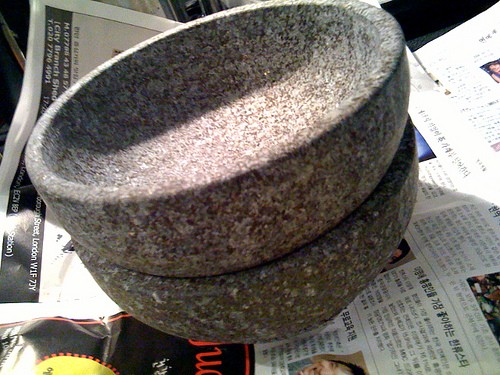
One final word about rice: Koreans are a rice-eating people and you will normally be given a metal bowl of rice with your meal. Some places cook rice in burning-hot stone pots called dolsot. The best places serve stone pot rice and then put ginger in the pot with water to lift out the crust, which is served as a palate-cleansing soup at the end. If you run out, you can ask for more (you may be charged a couple of dollars, especially for stone pot rice). If you are having trouble, the Korean you're looking for is, “Pap chom to chuseyo.”
Next week Ethnic Eating 101 will cover the opposite ends of the temperature spectrum: a fiery hellbroth of tofu, meat and chilies served literally boiling hot, and buckwheat noodle soup so cold you literally have to scoop ice to the side to get to it.


2 Replies to “Ethnic Eating 101: Korean, Part 1”